The 2023 Medicare Trustees report sends another warning: Medicare, the $1 trillion government health program that covers 65 million senior and disabled citizens, is facing big fiscal and programmatic challenges. If officials in Washington continue to ignore these challenges, seniors and taxpayers will pay a painfully high price.
The new Medicare Trustees annual report does not dramatically differ from previous reports. Once again, the Trustees repeat the somber warning:
The financial projections in this report indicate a need for substantial changes to address Medicare’s financial challenges. The sooner solutions are enacted, the more flexible and gradual they can be. The early introduction of reforms increases the time available for affected individuals and organizations—including health care providers, beneficiaries, and taxpayers—to adjust their expectations and behavior. The Trustees recommend that Congress and the Executive branch work closely together with a sense of urgency to address these challenges.REF
The Trustees are calling for “substantial” changes to the program—not mere tweaks to existing components of the federal entitlement. They are calling on the President and Congress to act cooperatively with a sense of “urgency.” An “early” intervention buys precious time for all affected persons to plan and avoid the massive disruption that continual delay guarantees. Given the sheer size and rapid growth of the Medicare entitlement, its impact on the federal budget, and the broader health care economy, all Americans will be affected, one way or another, by what the President and Congress do—or fail to do.
The Raw Facts
The Medicare Trustees outlined the challenges in their 58th annual reportREF on the troubled program:
- The Medicare hospital insurance (HI) trust fund is scheduled to become insolvent in 2031. This means that in 2031 Medicare will be unable to pay for all promised benefits, and Medicare patients will face an initial 11 percent cut in their hospital benefits.
- Total Medicare beneficiary enrollment rises from 65 million in 2022 to 83.4 million in 2040.
- Total annual Medicare spending jumps from roughly $1 trillion in 2023 to nearly $2 trillion in 10 years.
- Medicare’s dysfunctional payment system threatens patients’ access to quality care from hospitals, medical facilities, and even physicians.
- Medicare’s mounting long-term obligations dwarf America’s national debt, amounting to $51.3 trillion (in present value) over the next 75 years.
The Path Forward: Building on What Works
Given the rapid increase in the size of the Medicare population and the increasing per capita cost of delivering high quality care, driven in part by advancing medical technology, American taxpayers and beneficiaries will pay much more for Medicare benefits and services well into the future.
The more important question is whether Washington policymakers can improve the efficiency and effectiveness of medical care delivery and secure better value for Medicare dollars. By securing better care at lower cost, such a policy would not only slow down Medicare’s cost growth but would also improve quality of care. Based on the evidence thus far, the best means to achieve those ends is a system of defined contribution financing, harnessing the power of personal choice and intensifying market competition among health plans and providers.REF
Such a system is already in place within the Medicare program: Medicare Part C, also known as Medicare Advantage (MA).REF MA is a defined contribution model of health care financing, which means that the government makes a direct contribution, based on a formula, to the plan of a beneficiary’s choice. For the beneficiary, the choice among competing private health plans is also a choice of comprehensive health care coverage. MA plans provide the required standard Part A and Part B benefits of traditional Medicare, but generally at costs below that of traditional Medicare itself.
In 2022, for example, MA plan bids to offer traditional Medicare benefits averaged 85 percent of traditional Medicare spending.REF By law, plans are paid more because MA plans offer additional benefits not available through traditional Medicare, such as dental, vision, and hearing benefits, as well as certain supplemental benefits, plus protection from the financial devastation of catastrophic illness. When beneficiaries enroll in MA plans, the standard, taxpayer-subsidized Part B premium is applied to the cost of their MA coverage. Remarkably, in 2022, 69 percent of beneficiaries paid no more than the standard Part B premium for these comprehensive health plans.REF It is not surprising, therefore, that MA already enrolls roughly half of all Medicare beneficiaries and is soon to be the dominant form of Medicare coverage.
While it has certain fixable defects, MA can provide a strong platform for comprehensive, long-term Medicare reform.REF Policy changes to expand and improve the MA model would include substituting MA for traditional Medicare as the default enrollment for newly eligible seniors; reforming the plan and risk-adjustment payments to improve price competition and eliminate insurer gaming of the system at the expense of taxpayers and seniors; consolidating Medicare Parts A and B; and requiring traditional Medicare to compete as a stand-alone option alongside the private MA plans on a level playing field.
The Scope of Medicare’s Financial Challenges
In their 267-page report, the Trustees provide an update on the health and financial status of the Medicare program and outline a series of short-term and long-term problems that Congress and the White House must address.
Medicare Spending Growth. The Trustees routinely measure the growth of Medicare in terms of its share of the nation’s economy as measured by gross domestic product (GDP). Under current law, and the Trustees’ “intermediate” assumptions, total Medicare spending is projected to increase from 3.7 percent of GDP in 2022 to 6 percent of GDP in 2047, or under a more realistic “alternative” scenario, rising to 6.4 percent in 2047.REF In short, Medicare is projected to grow faster than inflation, wages, the general economy, and faster than private health insurance spending and overall national health spending. The Trustees again warn: “Growth under either of these scenarios would substantially increase the strain on the nation’s workers, the economy, Medicare beneficiaries, and the Federal budget.”REF
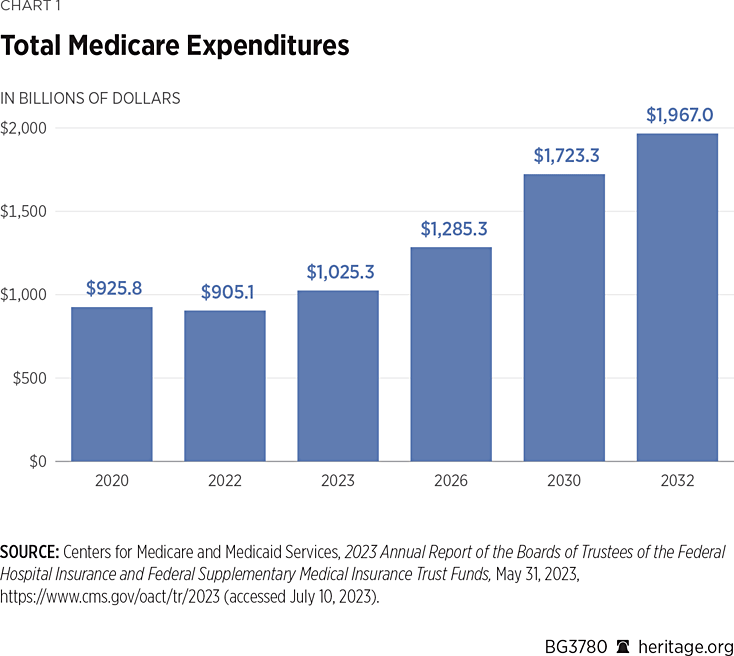
Hospital Insurance (HI) Insolvency. The Medicare Part A HI trust fund reimburses hospitals, nursing homes, home health agencies and hospice care facilities. Over the next five years, HI spending is projected to grow at an average annual rate of 8.9 percentREF and the HI trust fund is set to be insolvent in 2031.REF This does not mean a complete financial collapse, but it means that Medicare will not be able to reimburse providers for all the promised benefits financed by the HI trust fund. In 2031, Medicare will only be able to pay 89 percent of the costs of the promised Medicare benefits; and, short of direct congressional intervention, these benefit payments would continue to decline thereafter.REF
The result: Medicare beneficiaries could be badly hurt. As the Trustees say: “If assets were depleted, Medicare could pay health plans and providers of Part A services only to the extent allowed by ongoing tax revenues—and these revenues would be inadequate to fully cover costs. Beneficiary access to health care services could rapidly be curtailed.”REF
Medicare HI trust fund is financed on a pay-as-you go basis, meaning that current Medicare payroll taxes collected from employers and employees fund the current benefits of Medicare beneficiaries. The benefit payouts, therefore, are dependent on the trust fund taxes collected. The HI trust fund has no independent borrowing authority or capacity to tap into the general fund of the Treasury to cover the cost of the benefits.
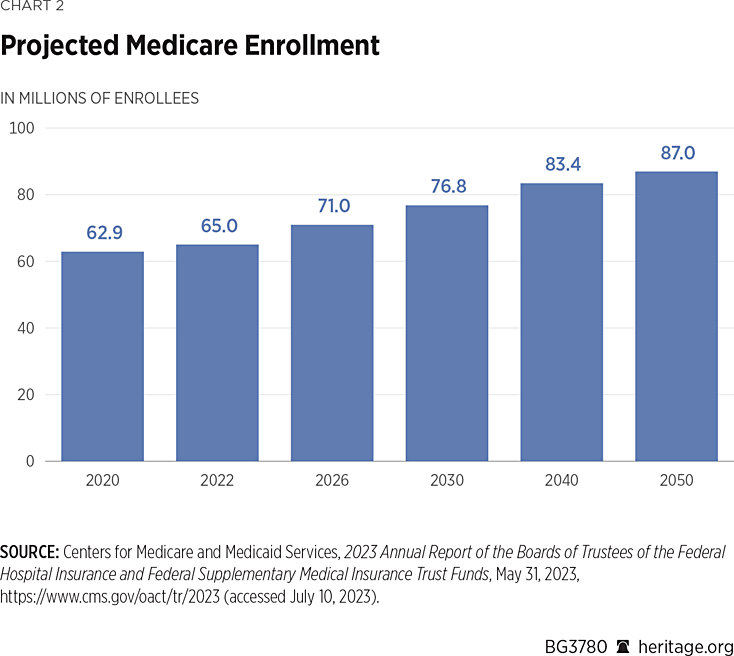
At the same time, America’s population is rapidly aging, and the older population is also living much longer in retirement than previous generations. With an ever-larger population eligible for Medicare at age 65, the United States will experience an unprecedented demand for medical benefits and services among a population that suffers from chronic, complex, and often difficult medical conditions. Beyond the increasing per capita costs of treating the Medicare population, the rise in sheer numbers guarantees a much larger financial commitment on the part of America’s taxpayers.
The demographic imbalance—a relatively smaller working population supporting a considerably larger beneficiary population—worsens the financing problem. As Chart 3 shows, four workers were supporting each beneficiary in 1980; but that is expected to drop to 2.3 workers by 2042.
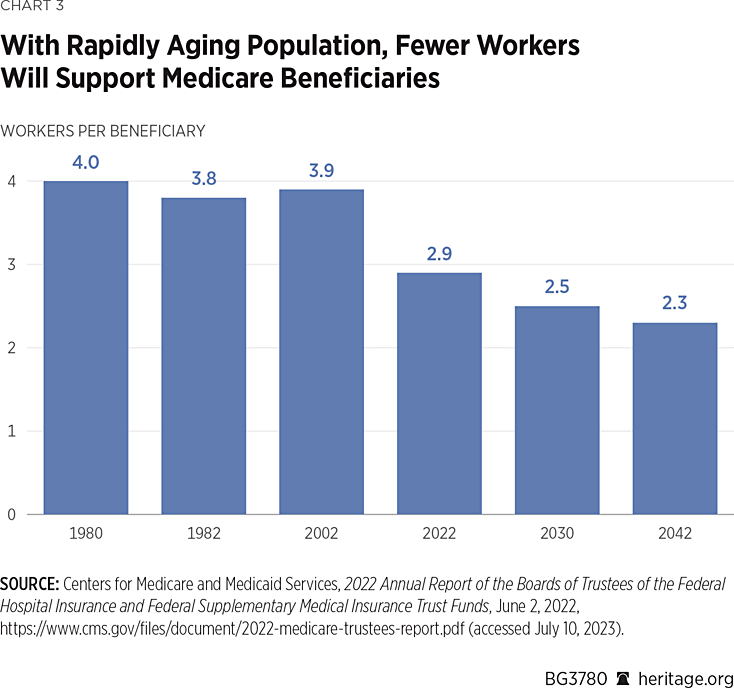
None of this should be surprising. For years, the Medicare trustees have been warning Congress and the White House that the HI trust fund meets neither its short-term nor long-term standards of “financial adequacy.” While the Trustees recommend that trust fund assets should equal, at a minimum, 100 percent of HI expenditures in any given year, Congress and the White House routinely ignores the recommendation.REF For 2023, the trustees estimate HI assets equal no more than 49 percent of the projected HI expenditures and are expected to further decline drastically to 16 percent in 2030.REF Meanwhile, Medicare HI expenditures continue to outpace income, the annual deficits progressively deepen, and the Trustees’ best estimate is that the HI trust fund runs headlong into insolvency in 2031.REF
To eliminate the HI deficit permanently, the Trustees outline two scenarios illustrating the magnitude of the problem. The first would require increasing the current Medicare payroll tax immediately from 2.9 percent to 3.52 percent. The second would require cutting Medicare benefit payments immediately by 13 percent.REF As the Trustees indicate, Congress is not likely to pursue either course and will probably resort to more incremental measures. Nonetheless, no matter which solution Congress chooses to cope with the inevitable HI problem, the longer the delay, the greater the pain that will be inflicted on Medicare beneficiaries and federal taxpayers.REF
Supplementary Medical Insurance (SMI) Costs. While media coverage of the Medicare Trustees’ annual report focuses heavily on the looming insolvency of the HI trust fund, the more significant Medicare financing challenge is the SMI program. SMI funds two voluntary benefit programs: It funds Medicare Part B for services provided by physicians and other health care providers as well as for outpatient medical services, and it funds the Medicare Part D program that provides prescription drug coverage.
The SMI fund does not and cannot face trust fund “insolvency” like the HI hospitalization program. The reason: Under current law, any annual increase in SMI costs is automatically covered by a drawdown of general funds from the Treasury. Today, general fund revenues account for roughly three-quarters of the total SMI funding, with Medicare beneficiary premiums and other small funding streams funding the remainder. The SMI trust fund, in other words, functions simply as a mechanism for the automatic pass-through of general tax financing. It is exempt from the annual congressional appropriations process and in federal budget lingo, Medicare SMI spending is classified as “mandatory,” as opposed to “discretionary,” federal spending.
Part B benefit payments are projected to grow from $487.9 billion today to slightly more than $1 trillion in 2032.REF Part D benefit payments are projected to grow from $129.5 billion today to $205 billion in 2032.REF Over the next five years, the Trustees project Part B growth to average 9.7 percent and Part D growth to average 6.2 percent,REF much faster than wages or the projected growth in the American economy as measured by GDP at an average annual rate of 4.3 percent.REF
While the next five-year projection indicates a slower rate of growth than the previous five years, SMI would still be growing faster than wages, inflation, and, of course, the general economy. SMI growth is thus a challenge for both beneficiaries and taxpayers.
From the standpoint of the federal budget and the federal taxpayers, the rapid growth in SMI costs, and the sizeable increases in drawdowns from the general fund, will present the biggest challenge. In 2019, SMI spending alone consumed 17 percent of all federal income taxes; by 2030, this part of the program will consume 22 percent, and by 2040, 26.9 percent of all federal income taxes.REF
Most beneficiaries have their Part B Medicare premiums deducted from their Social Security checks each month. From the standpoint of the beneficiaries, the Trustees estimate that the combination of Part B and D premiums, plus cost sharing in these programs, accounts for 28 percent of the average Social Security benefit this year.REF Between 2023 and 2032, the standard monthly Part B premium would increase from $164.90 to $285.60, while the annual deductible would jump from $226 to $399. Over that same period, the standard Part D monthly premium increase is projected to be modest, rising from $32.74 to $49.08, while the annual deductible would decline from $505 to $500.REF
Overall, the relentless drawdown on the federal Treasury is changing the character of the Medicare program. In 1970, workers’ payroll taxes accounted for 61.8 percent of all Medicare funding, beneficiary premiums 13.7 percent, and government contributions (general revenue drawdowns) just 24.6 percent. By 2030, workers’ payroll taxes will account for 29.9 percent, beneficiary premiums 17.2 percent, and the government contribution 47.1 percent.REF
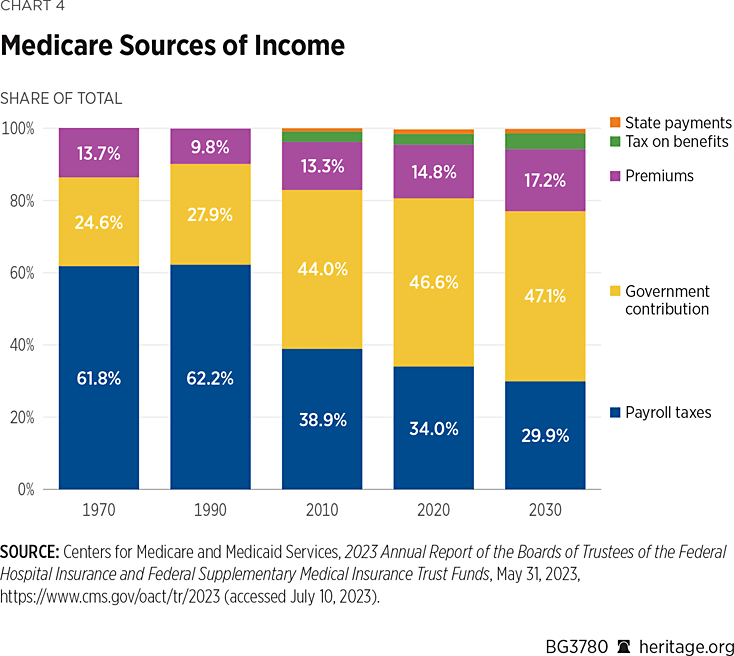
While Medicare is still often characterized as a “social insurance” program, where the beneficiaries are largely responsible for financing their own benefits, the increasing dependence of the program on general revenue funding is eroding that traditional claim. In fact, the program is increasingly taking on the character of a conventional income transfer from working families to beneficiaries, including upper-income beneficiaries. Though Medicare beneficiaries often angrily insist that they have “paid” for their benefits, the reality, regardless of income, is that current and future beneficiaries have received, and will receive, generally, far more in benefits than they paid into the program.REF
Long-Term Obligations. Medicare’s long-term impact on current and future federal taxpayers—measured over the Board’s 75-year actuarial window—is comparable in some ways to the long-term impact of the national debt: the imposition of an ever-larger set of financial obligations on current and future generations. In the case of the national debt, enlarged by mounting annual deficits, the total obligation is now approximately $32 trillion—about $98,000 per person in the U.S. In the case of the Medicare program, current and future taxpayers are saddled with long-term (75 years) unfunded obligations for both the HI and the SMI programs, meaning the dollar amount of the promised Medicare benefits that are not paid for by dedicated revenues, such as premiums and payroll taxes. This year, the Trustees are projecting a long-term unfunded Medicare obligation of $53.1 trillion.REF That would amount to about $160,000 per person in the U.S.
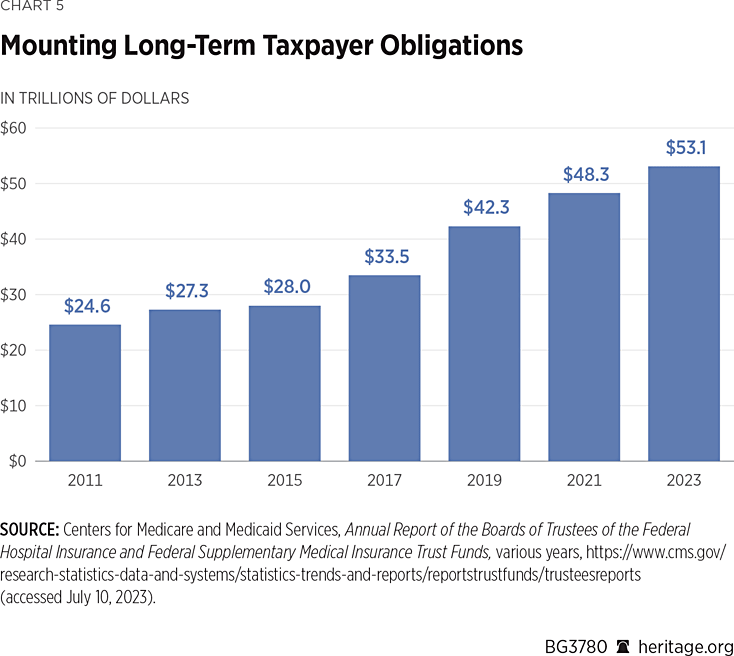
Congress has recognized, in statute, that excessive drawdowns on general revenues to finance the program has significant fiscal implications for federal spending, deficits, and debt. Under current law, if the Trustees project drawdowns on general revenues to exceed 45 percent of the program’s total expenditures in two consecutive years, then the Trustees are required to issue a Medicare “funding warning.” When the warning is formally issued, the President is legally required to submit remedial legislation to Congress within 15 days of his annual budget submission to address the excessive general revenue funding. Under current law, Congress is required to consider expeditiously the President’s legislative recommendations or alternative legislation.
Funding Warnings Ignored. This year, the Medicare Trustees once again issued their determination of “excessive” general funding for the program for the seventh year in a row and issued a Medicare-funding warning for the sixth consecutive year.REF Previous warnings have been conspicuously ignored by both Democratic and Republican Presidents, and Congress has thus far ignored its own self-imposed requirement to present a legislative fix in the absence of a presidential proposal.
Medicare Payment Rates vs. Beneficiary Access and Care
As part of its annual report, the Trustees typically assess the adequacy of payment rates in the Medicare program. This year, the Trustees reported that the adequacy of payment rates is uncertain.
Traditional Medicare reimburses hospitals, medical professionals, and related Medicare providers through a set of complex administrative payment formulas, combined with payment caps, which often have little or no connection to anything even vaguely resembling market-based pricing and payment of medical services. In any given instance, Medicare may pay too much or too little, but the general pattern is that Medicare payment is routinely well below private-sector payment for medical goods and services. For example, according to the Office of the Actuary at the Centers for Medicare and Medicaid Services (CMS), Medicare payment for hospitals fell to 60 percent of private insurance rates in 2019, and physician payment fell to 72 percent of private rates in 2020.REF
Traditional Medicare highlights the dilemma of creating and maintaining a politically driven system of government central planning and comprehensive price controls. The government can easily “save” money by ratcheting down physician and hospital administrative payments, which has been a routine congressional response to secure annual budget savings. Pursuing an aggressive government price-control strategy incurs an inevitable cost: reduced access to care or high-quality care among Medicare patients. It is not surprising that Congress has sometimes reversed course, and blocked or canceled its Medicare payment reductions in the face of intense political pressure from medical professionals, hospitals, and seniors’ organizations. The result: Medicare entitlement spending continued to increase.
Medicare physician payment is a classic example. The revised physician payment system, enacted under the bipartisan Medicare Access and CHIP Reauthorization Act (MACRA) of 2015, replaced the failed sustainable growth rate (SGR) formula, which tied increases in Medicare physician payment to the performance of the general economy and, if implemented, would have resulted in significant reductions in Medicare payment.REF In 2015, Congress intended to stabilize Medicare physician payment. Ironically, because of the MACRA “reform,” physician payment is on track to trend downward and be lower than it would have been under the previous payment update program, the failed SGR. Thus, the Actuaries observe, “Absent a change in the delivery system or level of update by subsequent legislation, we expect access to Medicare—participating physicians to become a significant issue in the long-term under current law.”REF Medicare physician payment stands as an epic in congressional policy failure.
Even though they are reimbursed well below private-sector payment rates, under current law Medicare physicians face significant restrictions on their future reimbursement. For example, over the period 2023 to 2025, even with the rise in record inflation, Medicare physicians will not only have no increases, but they will have payment reductions. In 2026, their payments will be increased by less than 1 percent, regardless of the payment system under which they are being reimbursed, either the conventional Medicare physician payment or an alternative payment model (APM). In 2025 and 2026, the annual bonuses and the $500 million annual bonus pool evaporates.REF After 2025, the Medicare Actuaries observe that current law does not allow for variations in the face of changing economic conditions, payment will not keep pace with physician costs, and there will be a growing gap between private-sector and Medicare physician payment. Thus, they warn: “While there are mounting concerns in the near-term regarding Medicare physician payment rates, we expect that access to Medicare participating physicians will become a significant issue in the long term as these concerns continue to grow, absent a change in the delivery system or level of update by subsequent legislation.”REF
Today, nearly all physicians accept Medicare patients, whether they are enrolled in traditional Medicare or in MA, and only about 1 percent of doctors have opted out of Medicare completely. According to a 2022 Kaiser Family Foundation research report, “Across most specialties, the majority of physicians (at least 80 percent) accept new patients with Medicare and private insurance.”REF Medicare physician payment rates are, however, significantly less than private-sector reimbursement rates and, as the Trustees emphasize, the gap is expected to widen over time. That is why the large and growing cohort of Medicare beneficiaries have reason to be concerned. While past surveys are not necessarily predictive of future behavior, policymakers should not ignore them. For example, in a recent survey on physician compensation published by Medscape, 65 percent of doctors said that they will not accept future Medicare patients.REF Frustrated with burdensome regulatory requirements and continuing reimbursement reductions, any reduction in physician participation would have grave consequences for such a large and growing patient population. In any case, such survey data validates the Trustees’ concerns over the sustainability of Medicare’s physician payment rates.
Part A providers, including hospitals, home health agencies, and nursing homes, also face significant payment reductions. In 2011, Medicare payments were 68 percent of private payments for hospitals. Remarkably, Medicare payment was even lower than the nationwide average of Medicaid reimbursement at 71 percent of private payments. These lower Medicare payment rates fell even lower and by 2019 Medicare payment fell to just 60 percent of private hospital payment. Assuming no change, these payments would fall to about 40 percent of private-sector rates over the 75-year actuarial window projected by the Medicare trustees.REF Meanwhile, roughly two-thirds of American hospitals are losing money in delivering services to Medicare patients.REF
If current Part A payment formulas, as modified by the Affordable Care Act of 2010, remain in force, Medicare beneficiaries will face serious problems accessing affordable health care. The Actuaries project that under current payment formulas, by 2040, about one-third of American hospitals, and more than 50 percent of nursing homes and home health agencies would find themselves operating in the red, “raising the possibility of access and quality of care issues for Medicare beneficiaries.”REF
Getting Serious About Medicare’s Future
No matter which policy agenda the President and Congress finally adopt, there is, of course, no question that beneficiaries and taxpayers are going to spend a lot more on Medicare in the future than they have in the past. Over the next 35 years, the program will experience a 40 percent increase in the total number of Medicare beneficiaries, with the highest growth rate in the next 10 years.REF The biggest spike in spending, of course, will follow the rapidly retiring Baby Boom generation, especially over the next 10 years.
Policymakers must ask the right questions, focusing on the right problems to find the right solutions to the emerging Medicare crisis. They should question conventional wisdom and the standard approaches that have characterized Medicare policy over more than five decades. More government central planning and more elaborate schemes for provider payment are unlikely to result in higher quality care or lower cost. Likewise, simply cutting Medicare payments and threatening patients with reduced access to medical services even more than the level projected under current law is both ethically wrong and politically perilous.
In charting a new course, policymakers can achieve better results by promoting choice and competition and building on the best features found in the MA program, providing higher quality care, and doing so at a competitive price. According to the Medicare Payment Advisory Commission, the panel that advises Congress on Medicare reimbursement, private plans’ competitive bids to provide the standard Part A and Part B benefits average 85 percent of traditional Medicare costs. This is a promising foundation for a competitive system that can contain costs while offering comprehensive benefits. To set the stage for a phased-in system of reform, Congress could take three steps:
First, Congress Should Make MA Enrollment the Default for Newly Eligible Medicare Beneficiaries. This would reverse the current law, which makes enrollment in traditional Medicare the default enrollment. Such a change would require certain consumer protections and guardrails to ensure access to high-quality care, while also giving the Medicare enrollees the right to switch to traditional Medicare if they wish to do so.REF
Second, Congress Should Improve the MA Program, Especially Its Flawed Payment and Risk-Adjustment Systems. Under current law, all participating private plans must offer Medicare Part A (hospitalization) and Part B (physician and outpatient services). The government pays MA plans annually through a complex process. It is comprised of three interrelated elements.
First, private health plans offer bids at an amount that they estimate would cover a package of Part A and Part B benefits and services on a per capita basis. Private plans offer these bids for coverage on a county-wide basis. There are 3,142 counties in the United States.
Second, the CMS sets a benchmark payment amount, based on Medicare’s administrative payment system, to cover Parts A and B benefits and services for beneficiaries in any given county. The CMS further adjusts this benchmark payment for the competing plans based on the health risks of the enrolled beneficiaries and the plans’ quality ratings on the CMS five-star quality rating system. The higher the plan’s health risks and quality ratings, the higher the CMS benchmark payment.
Third, the MA payment includes a mandatory rebate system. If a plan bids above the CMS benchmark, the enrolled beneficiaries pay a higher premium to cover the costs over and above the benchmark payment. If a plan bids below the CMS benchmark, the plan must rebate the difference back to the government and the beneficiaries. For beneficiaries, the share of the rebate, based on a plan’s star rating, can range between 50 percent and 70 percent of the difference between the CMS benchmark and the plan’s bid. By law, the rebate for the beneficiaries must take the form of lower premiums, lower cost sharing, or the provision of additional benefits and services. Direct cash rebates to beneficiaries for choosing lower cost plans are prohibited under current law.
Higher Spending. As noted, health plans generally bid below the CMS benchmark, and the mandatory rebates have mostly taken the form of additional benefits and services for Medicare beneficiaries. As Urban Institute analysts have noted, the “paradox” of the MA payment system is that in 2022, for example, MA bids on average often come in well below the CMS benchmarks, but the government spending on the MA program averaged 104 percent of traditional Medicare spending.REF These higher government payments are attributable not to the failure of market-based competitive bidding, but rather to the CMS quality rating system, the CMS quality bonus program, the excessively high CMS benchmarks, and the “coding intensity” on the part of plans in addressing beneficiaries’ health risks and needs.REF
Under current law, market forces that would intensify price competition are frustrated. Bids must be based on CMS benchmarks, which, in turn, are based on complex systems of administrative payment; inflexible bureaucratic payments often unrelated to the dynamism of market forces that prevail among the medical professionals and institutions on the ground in the more than 3,000 counties throughout the nation. Provider payment in Medicare’s outdated fee-for-service system is sometimes too high, but more often it is too low, which, in turn, incentivizes providers to generate excess volume and secure higher reimbursement and thus higher spending. For doctors, operating in an open-ended entitlement of uncoordinated care, such an arrangement guarantees higher health spending.
Likewise, patients enrolled in traditional Medicare with Medigap coverage to cover Medicare cost sharing have strong incentives to drive excess utilization of medical services, thus guaranteeing higher premium and program costs.REF As Urban Institute scholars have noted:
Although TM [Traditional Medicare] has low administrative costs and pays health care providers rates typically lower than what commercial insurance plans have been able to negotiate, TM enrollees’ choices of providers are not constrained. This leads to care that can be uncoordinated and leaves few limited mechanisms to promote efficient use of health care services.REF
In short, MA plans can routinely bid below traditional Medicare in delivering traditional Medicare benefits because they are more efficient in care delivery. Like today’s employer-sponsored plans, most MA plans are managed care plans (health maintenance organizations and preferred provider organizations). They are characterized by provider networks, emphasize preventive care, and rely heavily on case management and care coordination. While doing so, they also generally maintain a strong performance in delivering high quality care.
Time for Change. Because MA’s payment system is tied to traditional Medicare administrative payment at the county level, the government contribution to private health plans is distorted by the old program’s administrative inaccuracies, resulting in contribution levels that can be either too high or too low. The better alternative would be to create a straight system of competitive market bidding among health plans to determine the government contribution to be made on behalf of enrollees to the plan of their choice. This has been the practice of the popular and successful Federal Employees Health Benefits Program (FEHBP) since its inception in 1960. To optimize price competition, Congress should also allow Medicare beneficiaries to keep 100 percent of any savings for choosing an efficient health plan.
The concept of straight competitive bidding to determine the government contribution to MA’s private health plans is hardly new. Since President Bill Clinton initially proposed such a payment reform for MA in his 2000 budget proposal—a reform later endorsed by President Barack Obama—the change could attract bipartisan support.
Such a change would have multiple advantages. Writing in JAMA Health Forum, Brian Miller of Johns Hopkins University and colleagues observe:
Basing plan payments on a competitive benchmark instead of a percentage of the FFS [fee-for-service] Medicare administrative benchmark would decouple the Medicare marketplace from administrative pricing. Risk adjustment and quality ratings would be applied equally to all plans, including the FFS Medicare plan. Private market actors like the American Medical Association’s Relative Value Update Committee could transition into new roles such as developing outcome measures for CMS or assisting health plans with constructing fee schedules.REF
In adopting such a payment change, Congress can consider several formulas, such as basing plan payment of the weighted average of the bids of competing plans in each region of the country; the bid of the second lowest cost plan, which today determines exchange plan payment under the ACA; or an average of the three lowest-cost plans in the bidding region, as originally proposed by The Heritage Foundation. Through experimentation or testing, Congress can determine which formula secures the strongest participation and ensures the affordability of health plan options for enrollees; the best balance between cost and access to care. With any payment change, however, Congress should also reform MA’s risk-adjustment system to determine—retrospectively—the true costs incurred by the health risks of the beneficiaries, rather than leaving it to prospective guesswork and the potential for health insurers to game the system.REF
Third, Congress Should Transform Traditional Medicare into a Competitive Plan. Traditional Medicare, as a fee-for-service alternative, should be required to compete based on price, service, and the quality of benefits and care delivery with MA plans and other private plan options, including employer-sponsored plans and other innovative plan options, such as direct primary care plans, that would emerge in the new marketplace for retirees. Analysts at the Congressional Budget Office (CBO) and the American Enterprise Institute and others have suggested the main outlines of such a transformation, including the combination of Medicare Parts A and B, a reform of the complex cost-sharing of the program, simplifying it and making it more rational and understandable for enrollees, plus the crucial addition of a catastrophic benefit.REF These sensible recommendations have been proposed for decades; it is long past time for their bipartisan adoption.
Reforming traditional Medicare and MA into a comprehensive defined contribution program will indeed save beneficiaries and taxpayers money. Former CBO Director Douglas Holtz-Eakin estimates that such a change would result in a 10-year savings at approximately $2.2 trillion.REF
The Big Picture
The Medicare Trustees’ warning is that under current law, Medicare costs will continue to accelerate, thus adding to deficits and debt, while access to care and the quality of medical services under the program will decline.
To reverse this trend, policymakers must not wait and allow the program’s value to decline. Failed attempts at “reform” based on government central planning, more elaborate administrative pricing, or “better” bureaucratic micro-management will not secure that value. Only a transparent market driven by patient choice and robust competition can do so.
For real Medicare reform, policymakers should turn to what works. Building on the best features of existing defined contribution models, especially MA, Medicare can be sustained and improved for those who depend on it, while securing better value for the health care dollars of beneficiaries and taxpayers alike.
Robert E. Moffit, PhD, is a Senior Research Fellow in the Center for Health and Welfare Policy at The Heritage Foundation.

